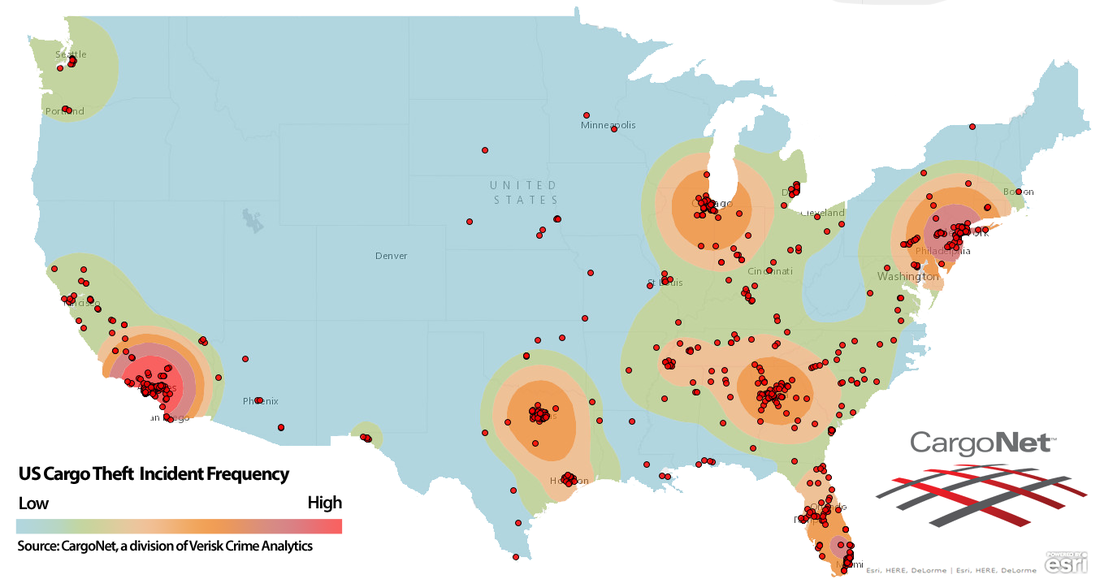|
By: Salvatore Marino, Vice President of Business Development, CargoNet
Drop a pebble into a fishpond and it creates a tiny ripple. What starts as a local event instantly surges outward, causing a ring of disturbance that grows as it travels across the water. Beneath the surface, the goldfish scatter as a mallard above beats a rapid retreat. And for those who may be dozing on the shoreline, a chain of events has begun that forces change in every direction. Read Article
0 Comments
CARGO Theft News: Indiana: (Video)Floyd Co. thieves busted for $400,000 in stolen sneakers3/23/2015  By James Jaillet @trucknewsJJ CargoNet’s heat map of cargo theft activity from 2014. Each dot represents a theft. Just shy of $90 million in cargo was stolen in 2014 in truck-trailer cargo theft incidents, according to a report released this month by CargoNet. Nearly half of that was high-value electronics loads, which averaged $549,539 in stolen goods per theft incident and totaled $42 million in the year. CargoNet’s figures are similar to those also released this month by FreightWatch International, with both reporting a small drop in the number of overall incidents but a sizable jump in the average loss value per incident. The number of incidents in the year fell to 844, CargoNet reports, down from 2013’s 1,098. The average loss value jumped from $143,957 in 2013 to $181,681 in 2014. CargoNet also says carriers and truck operators should be more attentive to vehicles trailing them, as the rise in organized cargo theft rings has given rise to thieves talking shipments from their point of origin, sometimes trailing loads hundreds of miles and across multiple states waiting on drivers to leave their truck and trailer unattended. “Truckers should frequently make sure they’re not being followed, especially by a car with multiple occupants and out-of-state plates,” CargoNet warns in its report. FreightWatch International in its 2014 report noted a similar trend, saying growing sophistication among thieves will likely mean fewer theft incidents but more targeted and highly planned thefts. Original Article Based on its annual analysis of cargo theft activity,FreightWatch International (FWI) believes the risk of cargo theft will increase slightly in 2015 versus 2014, many because cargo thieves continue to adopt what the firm describes “professional and sophisticated” tactics.
“Although the total number of verified incidents decreased by 12%, the threat of cargo theft continues to grow in the U.S. due to increased organization and innovation on the part of cargo thieves,” FWI said in its Annual Cargo Theft Report for 2014. “This evolution is illustrated by the 36% rise in average value [of cargo thefts] which suggests organized thieves offset the lack of access to a high quantity of shipments by targeting higher value merchandise,” the firm added. FWI recorded 794 cargo thefts throughout the U.S. in 2014, with the average value per theft reaching $232,924 – a 36% increase in value over 2013 – which translates into an average of 66 cargo thefts per month or 2.2 per day. The firm noted that while the “opportunistic” modus operandi (M.O.) is still the more prevalent tactic used by cargo thieves in the U.S. market, there continues to be a “global shift” towards more professional and targeted activity. “We have observed a global trend that this activity is a forerunner to organized criminals embedding themselves and their organizations deeper into cargo theft activities,” FWI said. “This resilient commitment is commonly a precursor to an escalation in risk – both in severity and frequency of attacks over time – and depending on conditions, can increase the likelihood of violence.” Still. FWI stressed that the U.S. “still enjoys” a relatively low level of cargo theft-related aggression and criminal sophistication compared to similar countries in Europe. Original Article Three suspects believed to be part of a Cuban gang stealing tractor-trailers along the East Coast were arrested in Wythe County on Wednesday night.
According to Wythe County Sheriff Keith Dunagan, the two men and one woman were captured near a trailer that was reported stolen at approximately 10 p.m. from Exit 41 off of Interstate 77. Read Article A trio of men stole several barrels of gold worth more than $4 million from a truck traveling through eastern North Carolina, leaving the vehicle's drivers tied up in the woods after they fled the scene, authorities said Monday.
The heist happened after the truck began experiencing mechanical problems late Sunday on Interstate 95 in Wilson County, the local sheriff said in a statement. The robbers tied up the two armed security guards escorting the shipment from Miami to Massachusetts and fled. Read Article |
Categories
All
Archives
February 2024
|
©2024 Transport Security, Inc. 820 South Pine Street Waconia, MN 55387 952-442-5625 enforcer@transportsecurity.com

 RSS Feed
RSS Feed